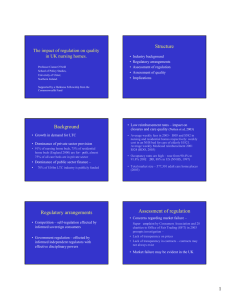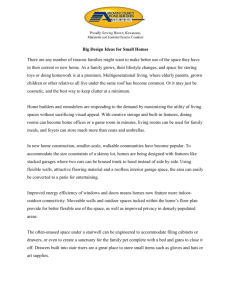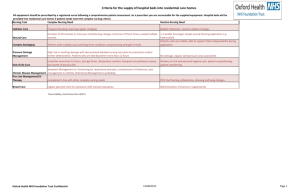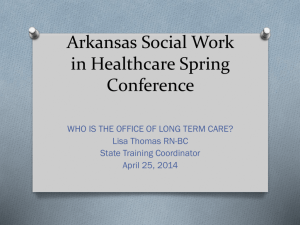The impact of regulation on quality in UK nursing homes.
advertisement
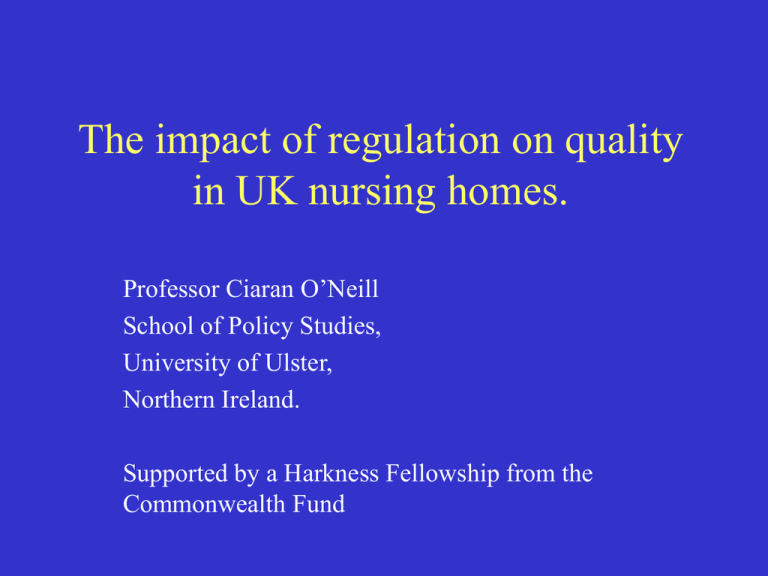
The impact of regulation on quality in UK nursing homes. Professor Ciaran O’Neill School of Policy Studies, University of Ulster, Northern Ireland. Supported by a Harkness Fellowship from the Commonwealth Fund Structure • • • • • Industry background Regulatory arrangements Assessment of regulation Assessment of quality Implications Background • Growth in demand for LTC • Dominance of private sector provision • 91% of nursing home beds, 75% of residential home beds (England 2000) are for-profit, almost 75% of all care beds are in private sector • Dominance of public sector finance – • 70% of $16bn LTC industry is publicly funded • Low reimbursement rates – impact on closures and care quality (Netten et al, 2003) • Average weekly fees in 2003 - $805 and $582 in nursing and residential homes respectively: weekly cost in an NHS bed for care of elderly $1821. Average weekly Medicaid reimbursement 2001 $824 (BDO, 2003) • Occupancy rates are high – rose from 90.4% to 91.8% 2002-2003, 88% in US (NNHS, 1997) • Total market size – 577,301 adult care home places (2003) Regulatory arrangements • Competition – self-regulation effected by informed sovereign consumers • Government regulation – effected by informed independent regulators with effective disciplinary powers Assessment of regulation • Concerns regarding market failure – Super-complaint by Consumers Association and 28 charities to Office of Fair Trading (OFT) in 2003 prompts investigation – • Lack of transparency on prices • Lack of transparency in contracts – contracts may not always exist • Market failure may be evident in the UK Government regulation Until April 2004 Care Standards Act 2000 (CHI) (NCSC) (inspection and enforcement) NHS Private sector nursing homes (189,000 beds) (193,000 beds) (26%) Private sector residential homes (345,000 beds) (74%) CHI = Commission for Health Improvement NCSC = National Care Standards Commission Concerns regarding government regulation – • Regulators are under-resourced -7 fold increase in beds, 3 fold increase in inspectors 1983-99 (Pollock 2004) • Regulators lack intermediate sanctions and are reluctant to use extreme measures • Standards are not legally enforceable, (no minimum staffing ratio), and are open to interpretation • Regulators risk “capture” by industry – industry represented on Regulatory Impact Unit, consumers are not. Industry has ear of government. NCSC activity specifically on nursing and residential care not reported but • Inspection – only 62% of planned unannounced inspections undertaken • Complaints – 8,311, 74% investigated by NCSC the remainder by the industry. • Statutory notices – 120, Prosecutions – 0, • Maximum fine available = $8,850 Health and Safety Executive 2003 • Notices issued = 102, Prosecutions = 12 Includes instances where patient was severely scalded despite 7 warnings from NCSC regarding failure to comply with standards, as well as an instance of resident death (HSE database 2004) • Maximum fine is unlimited – maximum issued to date $88,500, NCSC maximum fine $8,500 More effective enforcement activity by other agencies? Still: • 8,311 complaints in 2002/03 - not all relate to nursing home care • Worst case (all relate to NH) complaint per facility would be approximately 1.93, compared with 2.3 in US (HealthGrades 2003) • Mean time spent by nurses with patients higher in England compared with US, 155.5 minutes vs 115.9 minutes per day (Carpenter et al, 1997) • Trained nurse time as percentage of total, higher in England than US 53.2% vs 7.5% (Carpenter et al 1997) Assessment of quality • Concerns regarding quality – • Concerns regarding prescribing, staffing, access to medical care, patient documentation (O’Neill et al, 1999; Turrell,2001) • House of Commons Health Committee report on Elder Abuse April 2004 – highlights lack of information • But fundamentally a lack of information is apparent “The lack of reporting (on elder abuse) results in difficulties in determining the true scale of the problem and this is compounded by a dearth of research.” (House of Commons, 2004) • Inspection reports are available on web for England – but not Scotland, Wales or Northern Ireland. They are not moreover readily interpretable. • Concerns regarding validity and reliability of inspection – “capture of the regulators by industry” (Kerrison, 2001) • Change in regulatory arrangements as of April 2004 NCSC replaced by Commission for Social Care Inspection - lack of continuity Implications • Strengthen regulation: • User representation in the design of regulations and standards • Appropriate funding of inspectorate • Improve operation of market • Better information for consumers and advocates – not necessarily more information • Higher reimbursement – but linked to performance
